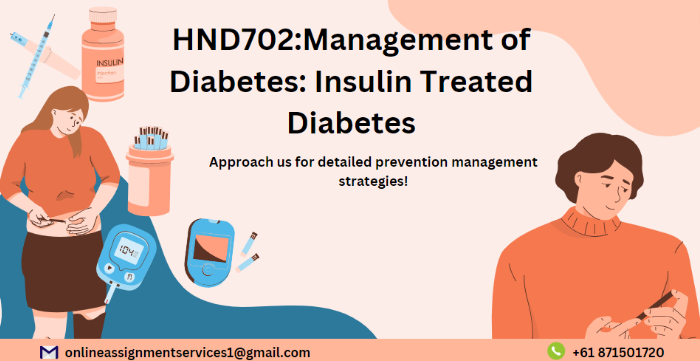HND702 Management of Diabetes: Insulin Treated Diabetes Assignment Help

Get Management of Diabetes assignment help like the solution below, with Online Assignment Services!
HND702 Management of Diabetes: Insulin Treated Diabetes Assessment requires a student to demonstrate their knowledge about acute diabetes complications and clinical management. In addition, the assessment is based on two main case scenarios, Part A and Part B, and the student is required to analyse the clinical information provided in given case scenarios to create diabetes management plans.
Part “A” is based on the given case scenario of 70-year-old woman Beata and requires the student to explain the diabetes-related health risk identified in Beata‘s clinical data and history. Moreover, students need to identify two priority problems in Beata’s case followed by discussing management strategies and education that would be provided to Beata.
Our skilled team at OAS has crafted a helpful example to support struggling students and provide comprehensive Management of Diabetes Assignment Help. We’ve partially covered both Part A and Part B to showcase how effectively our experts can meet various aspects of the assessment. Explore the sections below for clear guidance!
PART A
-
Identify and explain the diabetes-related health risks for Beata, based on her clinical data and history.
Diabetes is identified among the chronic set of diseases which is caused due to the inability of the body to uptake glucose from the body, leading to higher glucose concentration within the blood. This condition leads to a series of health-related risks, like hypertension, obesity, cholesterol, heart disease, kidney damage, eye damage and more (Uloko et al., 2018).
Based on the clinical data and the history provided by Beata, there are few diabetes-related risks that can be identified. The first one would be cardiovascular diseases (CVD). Studies have identified that over a prolonged period of time, high blood sugar levels can lead to damage in the blood vessels along with damage in nerves that engage in controlling the functioning of the heart. In addition to this, there are other conditions that increase the risks of CVDs within diabetic patients. One condition is high blood pressure, where there is an increase in the overall flow of the blood within the arteries which leads to damages in the walls of the artery. It has been noticed that Beata has high blood pressure, which is 135/85, where the normal range is 120/80 (CDC.a, 2022). Hence, the risk for Beata in gaining cardiovascular diseases is high. Next, the increase in LDL level, which is identified as bad cholesterol, leads to the formation of plaques along the damaged artery. In Beata, it has been identified that the report has 3.7 mmol/l which is a lot higher than the normal levels, which is 1.3 mmol/l. Hence, it increases the overall CVD risks in Beata (CDC.a, 2022). Next, HDL, which is good cholesterol, should be high, as the lower levels of HDL can lead to hardening of arteries and leading to CVDs. The condition is similar in Beata where the level of HDL is low, which is 0.8 mmol/l, where the normal level is 1.6 mmol/l (Gelissen & Brown, 2017).

-
(a) Prioritise two (2) clinical problems to focus on to improve the management of her diabetes.
Diabetes tends to contribute largely in terms of long-term complications. The longer the diabetes is, the greater the risk associated with gaining the complications. The clinical problems can be disabling and even threatening to life. One of the most common clinical problems is Heart and blood vessel (cardiovascular) disease. Diabetes has been identified to have increased the overall risk associated with heart problems. It has been identified that diabetes tends to damage the blood pressure. Diabetes also increases the risk of cholesterol which leads to the deposit of plaque on the blood vessels which would decrease the flow of blood as the passage of the arteries becomes narrow (Kalra & Sharma, 2018). This decreases the overall flow of blood which further leads to heart attack. There are further risks associated like increased chest pain, termed as angina, increased risk of stroke. The symptoms associated with cardiovascular diseases would include chest pain, increased pressure in the chest, increased discomfort in the chest, shortness of breath, and increased pain in the jaw and throat. In addition to this, there would be weakness, pain and numbness in the legs and arms.

(b) Explain strategies to manage these problems and describe the information/advice you would give to Beata about these two problems.
In terms of managing the clinical problem, of cardiovascular diseases, it would be important to follow a series of strategies. One would be to follow a healthy diet by Trent which would have a higher number of fresh fruits and vegetables with a lower amount of processed food. Any form of trans fat in the diet should be avoided with lower alcohol consumption (Ciffone & Copple, 2019). The next would be to aim for a healthy maintenance of weight as being overweight can lead to an increased risk of diabetes and cardiovascular diseases. The fat deposits in the blood vessels can lower the pressure of blood flow, leading to increased heart diseases. The next important strategy for Trent would be to maintain effective physical activities as studies have identified that greater physical activities increase the sensitivity of the body towards insulin, which in turn would ensure the uptake of the glucose from the blood to generate energy, hence managing diabetes effectively, which in turn lowers the risks of heart diseases (Banerjee et al., 2020).


Part B required the student to define and describe the clinical features and symptoms of diabetic ketoacidosis based on the case study of Fifteen-year-old Trent who recently experienced an episode of DKA and recovered from the same. Additionally, it was required that three major episodes that might have caused his condition be identified along with a presentation of a clear outline of three medical management priorities and three preventive strategies.
Our skilled experts have clearly explained scenarios in this management of diabetes assignment help solution, that contributed to his condition, priorities for medical management of Diabetic ketoacidosis, and outlined strategies Trent and his family could adopt to prevent DKA. Read on to get a gist!
PART B
-
Define diabetic ketoacidosis and explain the symptoms and clinical features.
Diabetes mellitus (DM) is identified as an endocrine disorder which causes an abnormality in the metabolism associated with blood glucose. Hyperglycaemia results in various complications, one of which is diabetic ketoacidosis (DKA). The condition, DKA, is identified to be a serious complication which arises when the body does not have the availability of enough insulin in the blood, which in turn interferes with the uptake of glucose by the cells from the blood to produce energy (Abbas et al., 2018). This leads to the liver causing it to break down fat to produce fuel which leads to the production of acids known as ketones. In this process of breaking down fats, a large amount of ketone gets produced in a rapid manner which further gets accumulated in the blood as well as urine to turn the blood acidic, which can be dangerous for the body. As per the research, the risk among people with diabetes type 1 is higher in terms of diabetic ketoacidosis (DKA) than diabetes type 2. This condition can be life-threatening and should not be neglected.

-
Identify three (3) scenarios that could have led to Trent developing DKA and explain why DKA is considered a medical emergency.
There could be various possible situations that could have led the fifteen-year-old Trent to develop DKA. The first one could be untreated type 1 diabetes or diabetes which remained undiagnosed. In type 1 diabetes, the beta cells producing insulin are identified as foreign which leads to an extreme depletion in the secretion of insulin and hence, the availability of insufficient insulin in the blood, prevents cells from absorbing glucose from the blood to produce energy (Ehrmann et al., 2020). As a result, the liver is stimulated to break down fat for energy, which results in the creation of ketones, an acid. When lipids are broken down, a lot of ketones is created quickly. This ketone then builds up in the blood and urine, making the blood acidic and causing DKA in Trent.

-
(a) Identify the top three (3) priorities for medical management of DKA and describe how these are administered.
Medical management is important within the healthcare sector in order to reduce the overall illness and death rates among the individuals which in turn would provide safer as well as more reliable services. In order to manage the DKA in Trent, there can be various medical management strategies. The first one would be, “fluid replacement” where Trent would be given fluids, either by mouth or by injecting through a vein in order to ensure rehydration. The fluids would help to replace the fluid which would get lost through excessive urination (Jayashree et al., 2019). The fluid replacement would also ensure the dilution of the excess sugar where the concentration of the sugar has been high.

(b) Explain three (3) strategies that Trent and his family could implement to prevent DKA.
There could be many strategies that can help Trent in preventing the body condition of DKA. The first one could be to keep track of the overall body ketone level. It would be advised to test for urines whenever Krent would be under extra stress or is undergoing any infection to check for the ketones. In order to test for the ketones, the over-the-counter urine ketones test kit can be used. It would then be advised by the family members of Trent to engage in contacting the doctor if the level is moderate or high (Ehrmann et al., 2020). Also, extremely low levels of ketones should also be contacted by the doctor.


